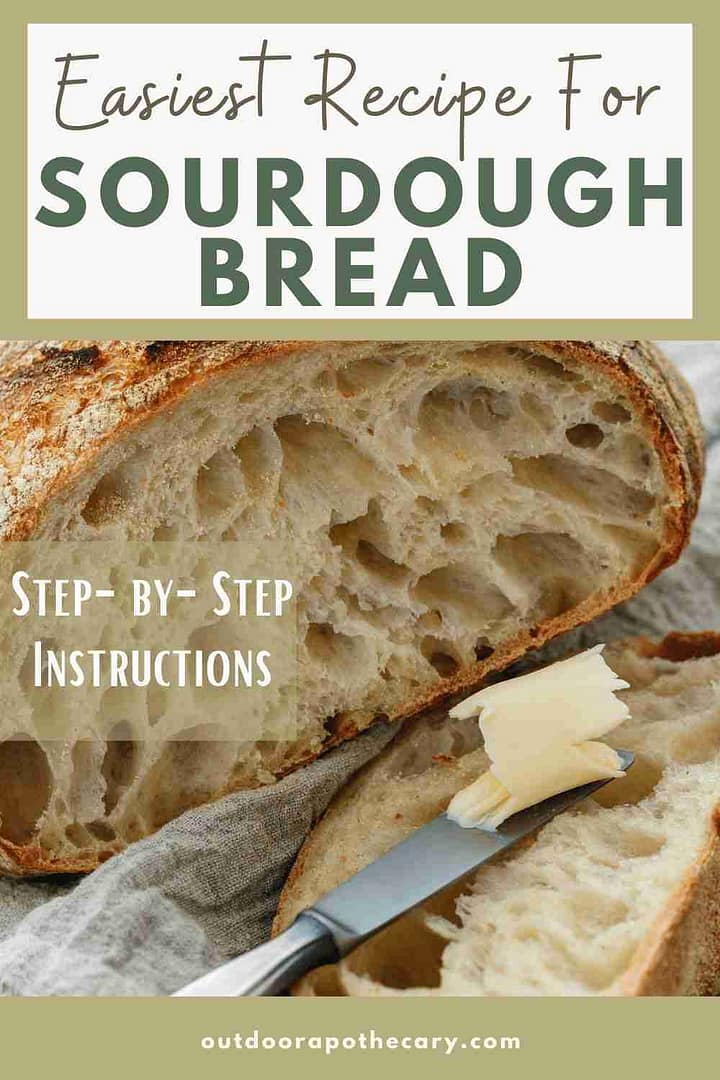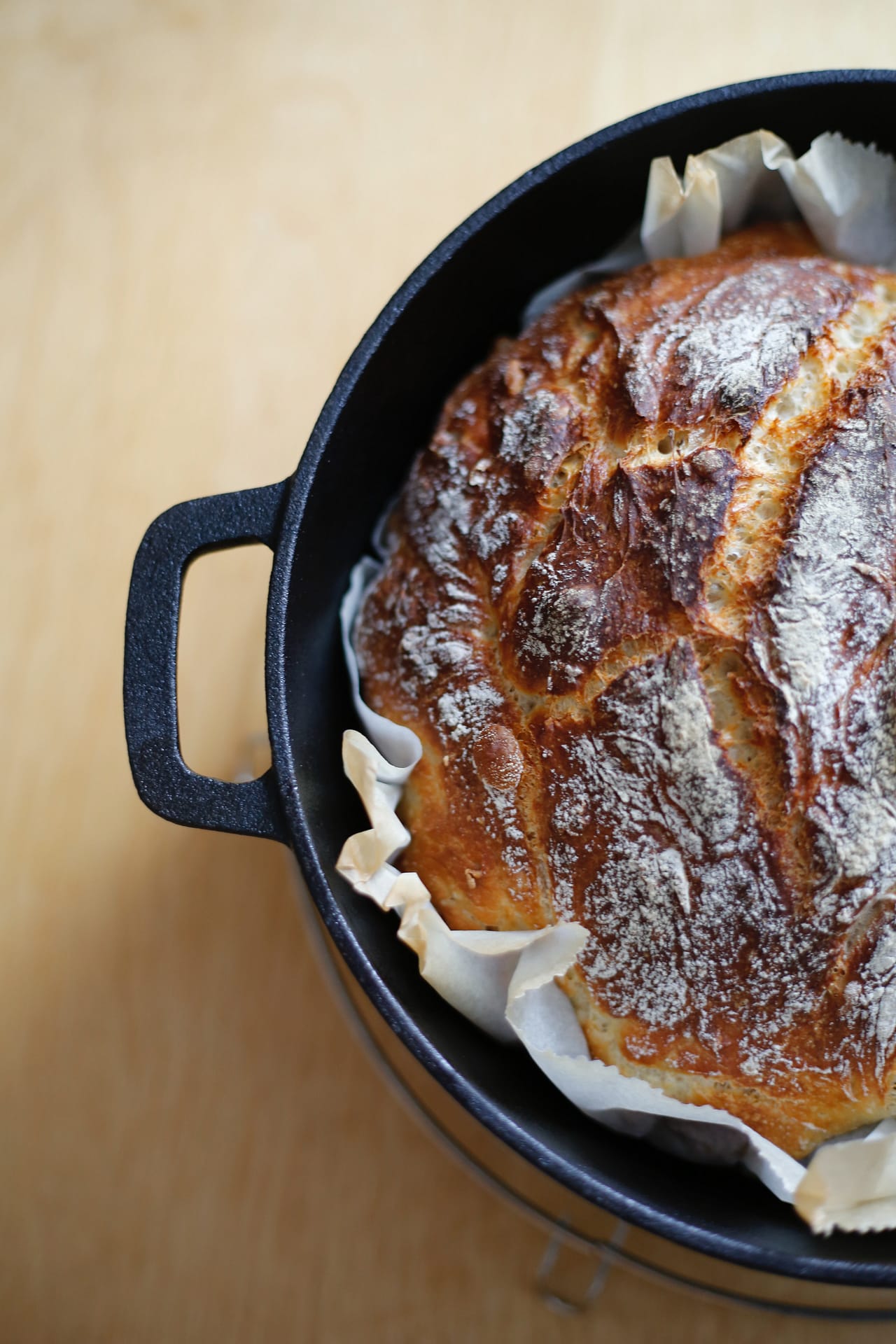The Outdoor Apothecary is reader-supported. When you buy through links on our site, we may earn an affiliate commission.Learn more
Are you intimidated by the thought of making homemade sourdough bread? Well, there’s no need to be scared with this super easy sourdough recipe from starter. This is one of the easiest sourdough recipes I’ve tried and is a great way to “get your feet wet” if you are brand new to bread-making.
This rustic no-knead sourdough bread has a chewy crust and a soft center, making it the perfect bread for sandwiches, and it tastes AMAZING paired with any kind of soup. It is pure comfort food!
Not only is this bread delicious, but it bakes up beautifully and is sure to become a staple of your self-sufficient house, not to mention it’ sure to impress your friends and family!
It's Easier Than You Think
To me, there is little else more comforting and homier than baking bread. It’s one of those old-time skills that our grandmothers’ perfected. I used to think that making sourdough bread was going to be time-consuming and extremely challenging, so for a while, I was reluctant to attempt it. Then a few years ago I made the decision to become more self-reliant and I knew that cultivating my ownyeast starterin order to bake my own bread was a necessary step on this journey.
Thankfully, I was wrong about the difficulty of baking bread from sourdoughstarter. It’s true that making sourdough bread takes a bit of time, but most of that time is spent waiting and is completely hands-off. And it’s definitely easier than I thought!
The key to that tangy flavor is the sourdough starter. You canmake your own,or if you’re lucky, you can get it from a friend.
Before making a sourdough recipe from starter, you want to make sure that yourstarteris active/healthy. You can tell whether your starter is active if the following are true:
- Your starter doubles in size within 4-6 hours of each feeding
- Your starter is full of bubbles that “grow” up the sides of your jar
- When you place a teaspoon of the starter in a cup of cool water, it floats on top of the water
My starter is usually about the consistency of pancake batter with lots of visible bubbles throughout, but yours may be runnier, or even thicker. What matters is that it is active and bubbly when you’re ready to bake.
Keep in mind: It takes about two weeks for a sourdough starter to be mature enough to leaven (rise) a loaf of bread. But the wait is worth it– promise.
Sourdough Recipe From Starter
Once you have a batch oflive, active starter, making sourdough bread is actually very easy.
Step 1. Making the Dough.
- To make the dough, combine some of the starter anda bit of warm water in a large mixing bowl.
- Add a couple of cups of all-purpose flour and salt.
- Form into a rough ball with your hands and let the mixture sit for 30 minutes. Do not knead or overmix.
Step 2. Allow Dough to Rise.
- After 30 minutes of resting time, you’ll want to stretch and fold your dough a few times and reform it into a ball.
- Wash the bowl and spray it with non-stick cooking spray, or place a lightly floured cloth inside so the dough doesn’t stick.
- Return the dough to the bowl or into a proofing basket (this helps the dough to retain its shape).
- Cover it with a clean dish towel and let the dough rise and double in size for at least 6–8 hours or up to 24 hours. I usually prepare my dough in the evening around 8 pm and stick it in the oven (turned off) until the next morning when I get up (I’m an early riser, so like 6 or 6:30 am).
The longer it sits, the more sour your bread will be.We like a mild sourdough, so I let mine sit for no more than 10 hours.
Step 3. Let it Rise Again.
In the morning, your dough should be double or more in size from the night before, and you’ll be assured that your starter was indeed active!
- Turn the dough out on your floured counter. Fold it over a couple of times to re-form it into a ball, then let it rest for 15 minutes.
- After this resting period is complete, gently shape the dough into a ball once more and then place it into a well-floured proofing basket or a bowl lined with a well-floured dish towel. Remember: don’t add too much flour and do not knead the dough!
- Cover and rise for 2–3 hours, or until doubled.
 Step 4. Baking the Bread.
Step 4. Baking the Bread.
Preheat your oven to 450 degrees. If using a Dutch oven, preheat it in the oven for 30 minutes prior to baking your bread.
You can bake your bread in an oven-proof bowl, loaf pan, or Dutch oven. ADutch Ovenhelps to trap steam inside – it’s this steam that is absolutely key to goodsourdough– it keeps the outside crust softer for longer as your dough expands with the heat.
Baking your bread in a Dutch oven will also result in a taller, more round loaf because the sides of the pan prevent the dough from spreading.
- To prepare, simply sprinkle a bit of cornmeal on the bottom of your Dutch oven, then carefully dump the dough from your proofing basket or bowl onto a sheet of parchment paper. Lift the parchment and dough and place inside your Dutch oven. These steps ensure that the bottom of your bread will not become over-browned in the baking process.
- Then, just before I put the dough in the oven, I cut a couple of slits across the top. (If you prefer, you can cut the slits before letting the loaf rise.)
- Place the lid on your Dutch oven and bake for 20 minutes.
- Remove the lid and bake for an additional 30 minutes, or until the loaf is deeply browned and crispy on top.
Tip: If you prefer a less crusty loaf, keep the lid on longer or the whole time.Move to a cooling rack and allow the loaf to cool completely before slicing it.

Once the bread is done baking, remove the loaf to a cooling rack.It cuts best if it cools for at least 30 minutes.
There you have it. Making a sourdough recipe from starter isn’t an exact science, so it may take you a few tries to come up with a loaf that your family likes the best.
You can make it more or less sour, with a softer crust or a crisper crust, just by tweaking a few steps. Have fun with it!

Storing & Freezing Sourdough Bread
For storing and freezing, be sure to wrap tightly with cling wrap or foil. You can also add it to a Ziploc bag after being wrapped to help stay fresh or freeze longer.
Tips for Working With Sourdough
Stickiness of the dough is a common challenge in the world of sourdough baking. The hydration level of your dough, which is the ratio of water to flour, plays a crucial role in determining its stickiness.
This sourdough recipe from starter has a relatively high hydration, which is great for achieving that lovely, open crumb and soft texture in your bread. However, it also makes the dough more challenging to handle. Adding more flour is one solution, but it can alter the final texture of your bread. Instead, you might want to try a few other techniques:
- Wet Your Hands: Before handling your dough, wet your hands. This can prevent the dough from sticking to your fingers without altering the dough’s hydration.
- Use a Dough Scraper: A dough scraper is an invaluable tool in sourdough baking. It helps in handling the dough and scraping it off surfaces without adding more flour.
- Improve Your Folding Technique: Remember to NOT knead the dough. Instead of kneading, this recipe benefits from a series of folds. This helps develop the gluten network without adding more flour. Be gentle and patient; it’s about coaxing the dough into shape, not forcing it.
- Flour Your Surface Judiciously: While you want to avoid adding too much flour, a light dusting on your work surface and the top of the dough can help manage stickiness during shaping.
Remember, sourdough is as much an art as it is a science. Each batch of dough can behave a little differently depending on various factors like room temperature, humidity, and the vitality of your starter. Embrace these variations and enjoy the process. With practice, you’ll get a feel for how to handle the dough in a way that works best for you. Keep experimenting, and happy baking!

Best Beginner Sourdough Bread Recipe from Starter
Barbi Gardiner
This is a basic sourdough bread that doesn't require kneading or complicated measuring and techniques. It produces a delicious, hearty loaf, perfect for people (like me) desiring a more self-reliant lifestyle.
4.25 from 20 votes
Print Recipe Pin Recipe
Course Bread
Cuisine American
Servings 12 slices
Equipment
Fork
Dish Towel
Dutch Oven
Ingredients
- ½ cup active sourdough starter learn how to make sourdough starter
- 1 ¼ cups lukewarm water
- 3 cups all-purpose flour
- 1 ½ teaspoons fine sea salt
Instructions
In a large bowl, combine the yeast starter and water.
Stir in the flour, and then add the salt.
Use a fork to mix everything together until it becomes stiff– then use your hands to bring the dough together to form a ball, but don't knead or overmix!
Place the dough ball in the bowl, cover it, and let sit for 30 minutes.
After this resting time is complete, stretch and fold the dough a few times and reform it into a ball again.
Cover the dough with a clean dish towel and let it rise in a warm place overnight or until doubled in size (or about 8 hours).
The next morning (or after 8 hours), turn the dough out on a floured surface. Fold it over a couple of times to tighten it into a ball, then let sit for 15 minutes.
After this resting period is complete, gently shape the dough into a ball once more place into a well-floured proofing basket or a bowl lined with a well-floured dish towel. Remember: don’t add too much flour and do not knead the dough!
Cover and rise for 2-3 hours, or until doubled.
Preheat the oven to 450°F. If using a Dutch oven, preheat it in the oven for 30 minutes prior to baking your bread.
Sprinkle a thin layer of cornmeal in the bottom of a Dutch oven (optional, but this helps the bottom of your bread not to become over-browned).
Carefully dump the dough ball out of the bowl onto a sheet of parchment. Place the parchment and dough into the Dutch oven.
Place the lid on the pot and bake for 20 minutes.
Remove the lid and bake for an additional 30 minutes, or until the loaf is deeply browned and crispy on top. (For a less crusty finish, bake for the entire time with the lid on.)
Move to a cooling rack and allow the loaf to cool completely before slicing it.
Keyword bread, bread recipe, recipe, sourdough, sourdough bread, sourdough bread recipe, sourdough starter
Tried this recipe?Let us know how it was!
We Think You Might Like This!
The Best Recipe for Sourdough Starter
As an Amazon Associate,I earn from qualifying purchases.


 Step 4. Baking the Bread.
Step 4. Baking the Bread.